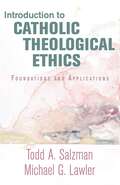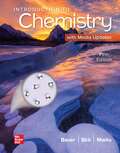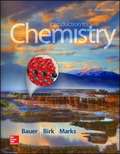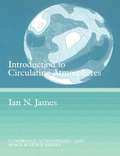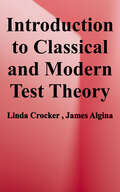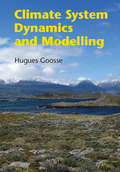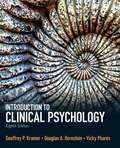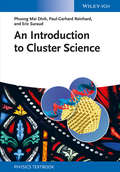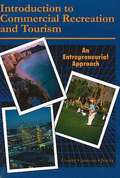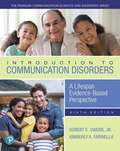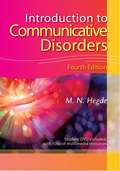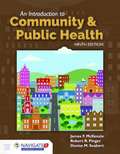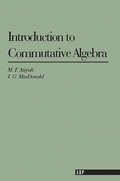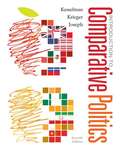- Table View
- List View
Introduction to Catholic Theological Ethics: Foundations and Applications
by Todd A. Salzman Michael G. LawlerTwo renowned, award-winning authors in the field of virtue and sexual ethics introduce and then apply their ethical method to such topics as relativism, ecology, bioethics, sexual ethics, and liberation theology. The result is a foundational text for undergraduate courses in Catholic theological ethics.
Introduction to Catholicism: A Complete Course (2nd Edition)
by James SociasIntroduction to Catholicism, 2nd Edition, contains the same Catholic teaching found in the popular original textbook, with expanded topics. Based on the Catechism of the Catholic Church, this text covers the basic tenets of the Faith and what it means to be Catholic; to include an additional 200+ pages, a new design layout, and additional pieces of full-color liturgical art. Topics include: The Holy Catholic Church The Blessed Trinity The Paschal Mystery The Blessed Virgin Mary The Sacraments and Prayer Christian Morality and the Universal Call to Holiness New chapter on Social Doctrine This textbook is published with ecclesiastical approval from the Archdiocese of Chicago.
Introduction to Catholicism: A Complete Course
by James SociasThis first book of the Didache Series explains what it means to be Catholic. The book presents Church Prayer Holiness The Trinity The Blessed Virgin Mary Sacred Scripture The Ten Commandments The Sacraments and more The Didache Series presents the life and doctrine of the Roman Catholic Church in the context of the Catechism of the Catholic Church and the teachings of Vatican II. The series draws from the Catechism of the Catholic Church, Sacred Scripture, the lives of the saints, the Fathers of the Church, and the teachings of Vatican II as witnessed by the pontificate of Pope John Paul II. This series is designed for high school and adult education, seminaries and colleges, RCIA, catechism classes, and home schooling.
Introduction to Chemistry
by Rich Bauer James Birk Pamela MarksThe fifth edition of Introduction to Chemistry continues to build on the belief that students learn best when the text and our classroom presentations focus on a conceptual approach to chemistry. <p><p>This book is grounded in educational research findings that address topic sequence, context, conceptual emphasis, and concept embedded numerical problem solving. Throughout the text, content is related to students’ daily lives and shows them how chemistry allows us to understand the phenomena—both simple and complex— that we encounter on a regular basis. This text presents macroscopic chemical phenomena early and uses familiar contexts to develop microscopic explanations. <p><p>Introduction to Chemistry is designed for the freshman-level Introductory Chemistry course that does not have a chemistry prerequisite and is suitable for either a one-semester course or a two-semester sequence. The book targets introductory courses taken by non-physical science majors who may be in allied health, agriculture, or other disciplines those that do not require the rigor of a science major’s General Chemistry course, or for students fulfilling university liberal arts requirements for science credits. In addition, students who lack a strong high school science background often take the course as a preparation for the regular general chemistry sequence.
Introduction to Chemistry
by Richard C. Bauer James P. Birk Pamela S. MarksIntroduction to Chemistry, 4e by Bauer/Birk/Marks offers today's student a fresh perspective to the introduction of chemistry. This textbook offers a conceptual approach to chemistry by starting first with macroscopic phenomena, and then presenting the underlying microscopic detail. Each chapter opens with a real-life scenario that helps students connect abstract chemical concepts to their own lives. The math found in Introduction to Chemistry, 4e is introduced on a need-to-know basis, with "Math Toolboxes" in select chapters to help support the math skills required in that chapter.
Introduction to Chemistry 1: How Can I Smell Things from a Distance?
by Joseph S. Krajcik Brian J. ReiserNIMAC-sourced textbook
Introduction to Chemistry 2: How Can I Make New Stuff from Old Stuff? (IQWST)
by Joseph Krajcik Brian ReiserNIMAC-sourced textbook
Introduction to Chemistry interactive SCIENCE
by Don Buckley Zipporah Miller Michael J. PadillaMiddle Grade Science Textbook
Introduction to Circulating Atmospheres
by Alexander J. Dessler John T. Houghton Michael J. Rycroft Ian N. JamesThis book gives an account of the modern view of the global circulation of the atmosphere. It brings the observed nature of the circulation together with theories and simple models of the mechanisms which drive it. Early chapters concentrate on the classical view of the global circulation, on the processes which generate atmospheric motions and on the dynamical constraints which modify them. Later chapters develop more recent themes including low frequency variability and the circulations of other planetary atmospheres. The book will be of interest to advanced students and researchers who wish for an introduction to the subject before engaging with the original scientific literature. The book is copiously illustrated, and includes many results of diagnostic and modeling studies. Each chapter includes a set of problems and bibliographical notes.
Introduction to Classical and Modern Test Theory
by Linda Crocker James AlginaStudents of modern test theory must acquire a base of knowledge about classical psychometrics, but they must also be able to integrate new ideas into that framework of knowledge. <p><p>This text was written to help the reader attain these ends. The reader who hopes to find only a series of “cookbook” steps on how to carry out any specific process, uncluttered by technical discussion or statistical symbols, will be disappointed. <p><P>We recognize that “best” or “most recommended” procedures for any aspect of test development may change as new ideas and empirical findings are published. Thus it seems desirable for the students of test theory to acquire some practice in reading material that contains technical terms and symbols similar to those which will be encountered as they graduate from a textbook and begin to read the professional literature independently.
Introduction to Climate Dynamics and Climate Modeling
by Goosse H. W. Lefebvre V. Zunz P. Y. Barriat M. F. LoutreAn open source textbook. Bookshare demo title.
Introduction To Clinical Psychology
by Geoffrey Kramer Douglas Bernstein Vicky PharesDesigned to provide a thorough survey of the field that is equally accessible to students with a general interest as well as to those with professional aspirations, this text presents a scholarly portrayal of the history, content, professional functions, and the future of clinical psychology.
An Introduction to Cluster Science
by Paul-Gerhard Reinhard Phuong Mai Dinh Eric SuraudFilling the need for a solid textbook, this short primer in cluster science is ideal for a one-semester lecture for advanced undergraduate students. It is based on a series of lectures given by the well-established and recognized authors for the past ten years. The book covers both the basics of the domain as well as up-to-date developments. It can be divided roughly into two parts. The first three chapters introduce basic concepts of cluster science. Chapter 1 provides a general introduction, complemented by chapter 2 on experimental and chapter 3 on theoretical aspects. The second half of the book is devoted to a systematic presentation of free cluster properties, and to a thorough discussion of the impact of clusters in other domains of science. These explicitly worked-out links between cluster physics and other research areas are unique both in terms of fundamental aspects and of applications, and cannot be found elsewhere in the literature. Also suitable for researchers outside of the field looking for an introduction to cluster science.
Introduction to Commercial Recreation and Tourism: An Entrepreneurial Approach (5th edition)
by John C. Crossley Lynn M. Jamieson Russell E. BrayleyIntroduction to Commercial Recreation and Tourism is a stepping stone to understanding the scope, characteristics, entrepreneurial strategies and management aspects of commercial recreation and tourism. Topics include the history of commercial recreation, definitions, economic applications, business start-up strategies, financing, marketing, operations management, and global trends. This edition also examines industry profiles for the travel, hospitality, and local commercial recreation industries. The Journal of Park and Recreation Administration viewed the past edition as a 'valuable addition to commercial recreation literature'.
Introduction to Communication Disorders: A Lifespan Evidence-Based Perspective
by Robert E. Owens Kimberly A. Farinella Dale Evan MetzA clear, comprehensive introduction to communication sciences and disorders Introduction to Communication Disorders: A Lifespan Evidence-Based Perspective presents recent advances in the assessment and treatment of communication disorders in a highly readable manner. Each chapter is concise, yet comprehensive-striking a just right balance of information appropriate for introductory-level students. Readers gain a basic foundation in the areas of anatomy and physiology of speech and hearing, and an overview of the various disorders that affect voice, fluency, articulation, language, cognition, swallowing, and hearing across the lifespan. Updated case studies, evidence-based practice summary boxes, and new medically based photographs help students bridge the gap between theory and clinical application.
Introduction to Communicative Disorders (4th edition)
by M. N. HegdeIn this update of the 2001, 1995, and 1991 editions, Hegde (communication sciences and disorders, California State U. , Fresno) introduces the rapidly growing science of communication and profession of communicative disorders. Coverage includes a new chapter on literacy skills in children and the role of the speech-language pathologist in literacy intervention; profiles of speech-language pathologists and audiologists; and expanded material on audiology, audiology rehabilitation, and disorders of swallowing. The text includes study questions; information on professional education, organizations, and standards; a glossary.
An Introduction To Community And Public Health
by James F. McKenzie Robert R. Pinger Denise SeabertAn Introduction to Community & Public Health, Ninth Edition provides learners with the latest trends and statistics in this evolving field. With an emphasis on developing the knowledge and skills necessary for a career in health education and health promotion, this best-selling introductory text covers such topics as epidemiology, community organizations, program planning, minority health, mental health, environmental health, drug use and abuse, safety, and occupational health. A robust pedagogy and enhanced digital learning component encourages students to understand and retain community health issues and better prepare for their future careers.
Introduction To Commutative Algebra
by Michael Atiyah I. G. MacdonaldThis book grew out of a course of lectures given to third year undergraduates at Oxford University and it has the modest aim of producing a rapid introduction to the subject. It is designed to be read by students who have had a first elementary course in general algebra. On the other hand, it is not intended as a substitute for the more voluminous tracts such as Zariski-Samuel or Bourbaki. We have concentrated on certain central topics, and large areas, such as field theory, are not touched. In content we cover rather more ground than Northcott and our treatment is substantially different in that, following the modern trend, we put more emphasis on modules and localization.
Introduction to Comparative Politics: Political Challenges and Changing Agendas, AP* Edition
by Mark Kesselman Joel Krieger William A. JosephNIMAC-sourced textbook
Introduction to Comparative Politics: Political Challenges and Changing Agendas
by Mark Kesselman Joel Krieger William A. Joseph"Introduction to Comparative Politics offers accessible material for an introductory comparative politics course. Edited by a highly respected team of scholars, each of the text' s twelve country studies is written by an expert in the field. Four innovative themes, each with a specific focus, form the framework of the text: "The World of States, "Governing the Economy, "The Democratic Idea, and "The Politics of Collective Identities. A classification system focuses on levels of democracy, including established, transitional, and non-democracies. A chapter on the United States follows the same lines of comparison as those on other countries. Every chapter includes four to six sidebars, which focus on different subjects, including leaders, citizen action, institutional intricacies, current challenges, and global connections.
Introduction to Comparative Politics: Political Challenges and Changing Agendas
by Mark Kesselman Joel Krieger William A. JosephNIMAC-sourced textbook
An Introduction to Compressive Sensing
by Wotao Yin Mona Sheikh Jason LaskaIntroduction to compressive sensing. This course introduces the basic concepts in compressive sensing. We overview the concepts of sparsity, compressibility, and transform coding. We then review applications of sparsity in several signal processing problems such as sparse recovery, model selection, data coding, and error correction. We overview the key results in these fields, focusing primarily on both theory and algorithms for sparse recovery. We also discuss applications of compressive sensing in communications, biosensing, medical imaging, and sensor networks.
Introduction to Computer Security
by Michael T. Goodrich Roberto TamassiaThis book is intended to provide an introduction to general principles of computer security from an applied viewpoint, common cyberattacks, including viruses, worms, password crackers, keystroke loggers, denial-of-service, DNS cache poisoning, port scanning, spoofing, and phishing.
Introduction to Computers and Information Technology
by Pearson Learning Solutions StaffIntroduction to Computers and Information Technology teaches essential computer technology concepts and skills. This text helps student build a concrete understanding of how computers work and how various types of computing devices and accessories are used in school, work, and at home. The book consists of three principle sections: Computing Fundamental explores hardware and software basics, input and output devices, storage, and operating systems. Applications teaches introductory skills in word processing, spreadsheets, database, presentation programs, and mutlimedia. Communications and Networks covers the latest in communications devices including smart phones and personal digital assistants as well as the network technology they run on.
